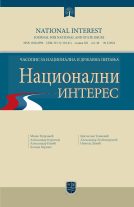- Home page
- Researchers
- Goran V. Nikolić
Goran V. Nikolić
Viši naučni saradnik, Institut za evropske studije, Beograd

ECONOMIC AND TECHNOLOGICAL RISE OF CHINA AS A NEWSPAPER OF THE NEW GLOBAL GEOPOLITICAL CONSTELLATION
Technological advances that China has managed to make in the last two decades, make it by far the most serious challenge to global hegemony that the two Anglo-Saxon countries (first Britain and then the United States) have encountered in almost three centuries.Along with a current trade war, the US and China have been entangled in rising competition to command different fields of next-generation technology, above all 5G networks and AI. The competition is in effect about who will control the international information technology infrastructure and standards. Beijing has prepared a number of plans, as was “Made in China 2025” aimed to dominate global high-tech manufacturing, with hopes to turn China into a world leader in 5G, AI, and other high technology areas. Тhe two countries are in one conflict with two different types of hostilities: a trade war and a ‘tech war’. The US might be leading in many areas, retaining a prime position especially in AI patents, investment, and academic research (which is expected as major software companies are based in the US). In 2020 China started its central-bank digital currency, but it, on its own, will not be a game changer increasing the Yuan’s role globally. Despite the technological sophistication of its retail payment systems, and introduction of China’s Cross-Border Interbank Payment System in 2015 able to bypass the SWIFT, as China’s central bank still manages the RMB’s exchange rate and restricts capital inflows/outflows, foreign and domestic investors are unlikely to view the renminbi as a world reserve currency. This will be true until Beijing decide to intensify reform of financial markets and remove restrictions on capital flows. Finally, it is very important to understand that in many aspects of technology China and the US are on two very different paths in terms of technological domination. Projections indicate that China will surpass the УС in terms of GDP at the end of 2020с, which will further complicate the fight for global supremacy. Looking at Belgrade's relations with Beijing, along strong intensificatin of diplomatic relations, it is a visible significant growth of Chinese investments (which are mainly financed with Chinese loans), and finally an increase in domestic exports to China.

THE TRADE AND TECHNOLOGY WAR BETWEEN AMERICA AND CHINA AS THE START OF A NEW COLD WAR?
In 2018, US merchandise imports from China was $540 billion with export from the US of only $120 billion. China has a large positive trade balance with the US and has used its dollar surplus to purchase US Treasury bonds – in that way holding the value of the dollar. The flight of production from the US to China and other countries has brought significant loss of jobs in America. Namely, the number of employees in US manufacturing industry has decreased by 34% in the period 1998-2010. The Chinese ownership of US debt provides it with prospective capacity to have an effect on US financial policy, as a rapid sale of Treasury bonds would diminish the US dollar and very likely carry out an increase of interest rates thereby making crediting more expensive. Having a huge and constant trade deficit with China, the US have hoped, which proved unrealistically, that raising tariffs and make stronger economic threats against China would push Beijing to make reforms that would decrease trade deficits and reinforce the position of US firms in China via the leaving of subsidies and the termination of mandatory technology transfer and intellectual property rights. Being in more difficult positions, Chinese firms - aming to minimize costs - are receding from global value chains that are susceptible to U.S. sanctions, producing inputs either domestically or within China’s sphere of influence. The prolonged trade conflict between the world‘s two largest economies will send shockwaves that will sweep through the entire global economy. Global competition between Washington and Beijing will intensify regardless of progress in resolving trade issues having in mind that the US policy is promoting a division of the world economy into two competing blocs. The ‘battle’ for dominance in the world economy will unfold in the next decades between those two powers, especially in communication and quantum technologies, AI (artificial intelligence), robotics and bioengineering. It will be almost impossible to avoid structural and very dangerous competition. This will undermine the inclusive geo-political strategy of so-called Western triad (the US, the EU, and Japan). The possible benefits of military action against China are, according to recent estimates, far outbalanced by the expenditures. The present logic of global politics is that Western powers could possible acknowledge the rise of China. It implies to include the state in the hegemonic core. Alternative is to be ready for the appearance of another hegemonic power. Generally, it seems that the West will have to accept that the world economic pole has shifted to China and the interests of this country cannot be longer ignored, as the cost of the possible conflict can be intolerably huge for all major global participants.
